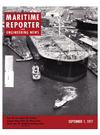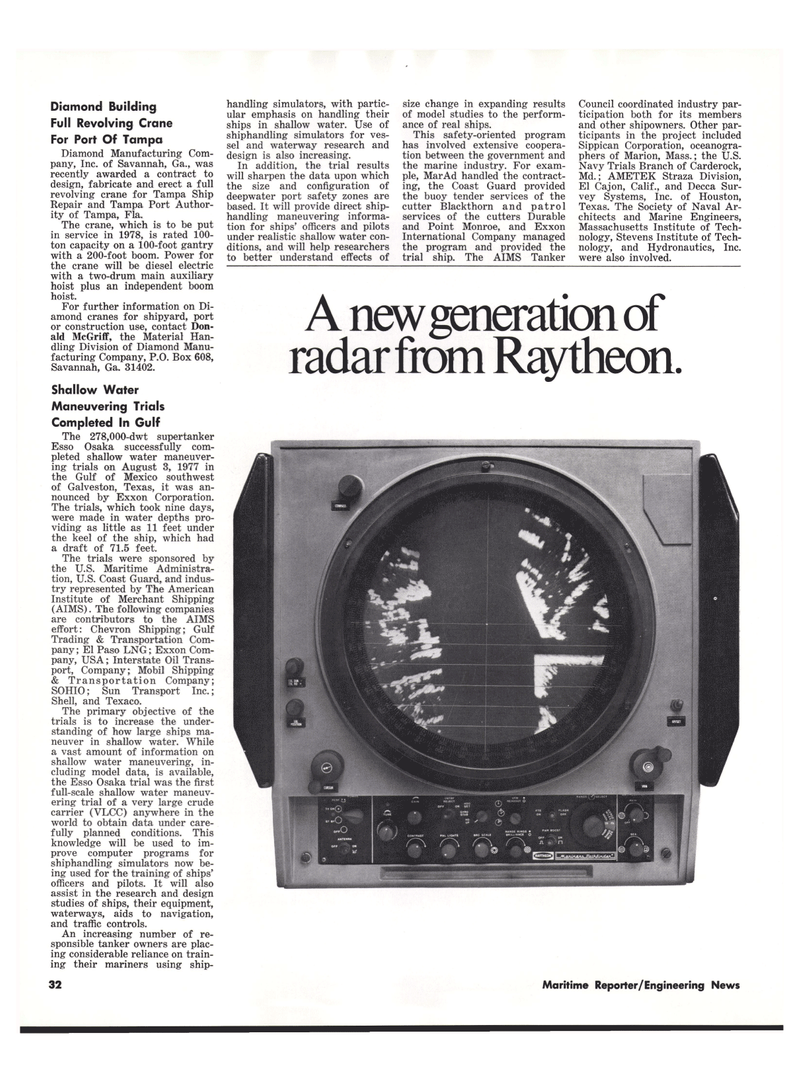
Page 28: of Maritime Reporter Magazine (September 1977)
Read this page in Pdf, Flash or Html5 edition of September 1977 Maritime Reporter Magazine
Diamond Building
Full Revolving Crane
For Port Of Tampa
Diamond Manufacturing Com- pany, Inc. of Savannah, Ga., was recently awarded a contract to design, fabricate and erect a full revolving crane for Tampa Ship
Repair and Tampa Port Author- ity of Tampa, Fla.
The crane, which is to be put in service in 1978, is rated 100- ton capacity on a 100-foot gantry with a 200-foot boom. Power for the crane will be diesel electric with a two-drum main auxiliary hoist plus an independent boom hoist.
For further information on Di- amond cranes for shipyard, port or construction use, contact Don- ald McGriff, the Material Han- dling Division of Diamond Manu- facturing Company, P.O. Box 608,
Savannah, Ga. 31402.
Shallow Water
Maneuvering Trials
Completed In Gulf
The 278,000-dwt supertanker
Esso Osaka successfully com- pleted shallow water maneuver- ing trials on August 3, 1977 in the Gulf of Mexico southwest of Galveston, Texas, it was an- nounced by Exxon Corporation.
The trials, which took nine days, were made in water depths pro- viding as little as 11 feet under the keel of the ship, which had a draft of 71.5 feet.
The trials were sponsored by the U.S. Maritime Administra- tion, U.S. Coast Guard, and indus- try represented by The American
Institute of Merchant Shipping (AIMS). The following companies are contributors to the AIMS effort: Chevron Shipping; Gulf
Trading & Transportation Com- pany ; El Paso LNG; Exxon Com- pany, USA; Interstate Oil Trans- port, Company; Mobil Shipping & Transportation Company;
SOHIO; Sun Transport Inc.;
Shell, and Texaco.
The primary objective of the trials is to increase the under- standing of how large ships ma- neuver in shallow water. While a vast amount of information on shallow water maneuvering, in- cluding model data, is available, the Esso Osaka trial was the first full-scale shallow water maneuv- ering trial of a very large crude carrier (VLCC) anywhere in the world to obtain data under care- fully planned conditions. This knowledge will be used to im- prove computer programs for shiphandling simulators now be- ing used for the training of ships' officers and pilots. It will also assist in the research and design studies of ships, their equipment, waterways, aids to navigation, and traffic controls.
An increasing number of re- sponsible tanker owners are plac- ing considerable reliance on train- ing their mariners using ship- handling simulators, with partic- ular emphasis on handling their ships in shallow water. Use of shiphandling simulators for ves- sel and waterway research and design is also increasing.
In addition, the trial results will sharpen the data upon which the size and configuration of deepwater port safety zones are based. It will provide direct ship- handling maneuvering informa- tion for ships' officers and pilots under realistic shallow water con- ditions, and will help researchers to better understand effects of size change in expanding results of model studies to the perform- ance of real ships.
This safety-oriented program has involved extensive coopera- tion between the government and the marine industry. For exam- ple, MarAd handled the contract- ing, the Coast Guard provided the buoy tender services of the cutter Blackthorn and patrol services of the cutters Durable and Point Monroe, and Exxon
International Company managed the program and provided the trial ship. The AIMS Tanker
Council coordinated industry par- ticipation both for its members and other shipowners. Other par- ticipants in the project included
Sippican Corporation, oceanogra- phers of Marion, Mass.; the U.S.
Navy Trials Branch of Carderock,
Md.; AMETEK Straza Division,
El Cajon, Calif., and Decca Sur- vey Systems, Inc. of Houston,
Texas. The Society of Naval Ar- chitects and Marine Engineers,
Massachusetts Institute of Tech- nology, Stevens Institute of Tech- nology, and Hydronautics, Inc. were also involved.
A newgeneration of radar from Raytheon. 20 Maritime Reporter/Engineering News

 27
27

 29
29
